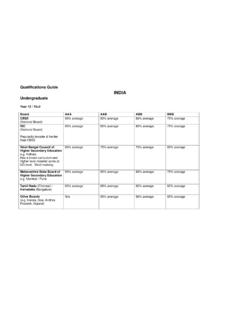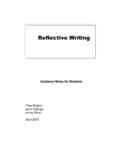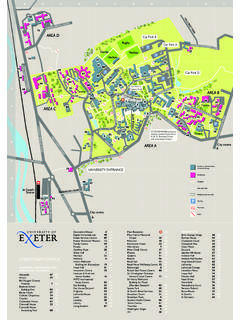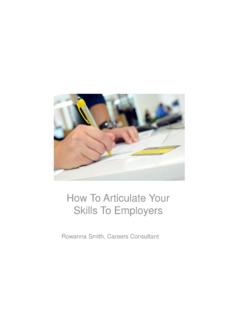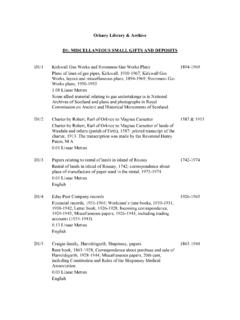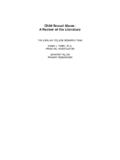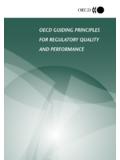Transcription of Defining/Confining the Duchess: Negotiating the …
1 Defining/Confining the duchess : Negotiating the Female Body in john Webster's "TheDuchess of Malfi"Author(s): Theodora A. JankowskiReviewed work(s):Source: Studies in Philology, Vol. 87, No. 2 (Spring, 1990), pp. 221-245 Published by: University of North Carolina PressStable URL: .Accessed: 05/03/2012 03:30 Your use of the JSTOR archive indicates your acceptance of the Terms & Conditions of Use, available at . is a not-for-profit service that helps scholars, researchers, and students discover, use, and build upon a wide range ofcontent in a trusted digital archive. We use information technology and tools to increase productivity and facilitate new formsof scholarship. For more information about JSTOR, please contact of North Carolina Press is collaborating with JSTOR to digitize, preserve and extend access toStudies in the duchess : Negotiating the Female Body in john Webster's The duchess of Ma by Theodora A.
2 Jankowski T | NHE relatively rapid appearance in mid-sixteenth-century Brit- ain of three reigning female monarchs severely taxed existing early modem political theory. The rich discourse that explored the various ramifications of the nature of authority and male ruler- ship had been remarkably silent about both the potential for and the nature of possible female rule. Thus, the presence of Mary Tudor and Mary Stuart on British thrones served to point out-to political theo- rists especially-that no language existed for describing the nature of female rule. That a large discourse did exist for describing mar- ried women-one that showed them to be subservient to their hus- bands-did not make the task of creating a political discourse for women any easier. In fact, the existence of such a powerful mode of describing married women as subject to their husbands prompted john Knox to argue in 1558 that the nature of female rule was "un- natural.
3 "' Whether this pronouncement was universally accepted or not is not important. What is important is that various "disastrous" events in the reigns of the two Marys served to cast severe doubt upon the nature of female rule itself, especially given the fact that monarchs had to marry to produce heirs. So strong was the tradi- tional belief in women as subservient beings that john Aylmer had 1 Uohn Knox], The First Blast of the Trumpet Against the Monstrvovs regiment of uwmen ([Geneva], 1558; rptd., Amsterdam: Theatrum Orbis Terrarum and New York: Da Capo, 1972) ( No. 15070). 221 ? iggo The University of North Carolina Press 222 The Female Body in The duchess of Malfi some difficulty in supporting the concept of a female monarch. His not very convincing argument was that a woman ruler could be "sub- ject to" her husband as he was her husband and yet "rule over" him as she was his magistrate.
4 While Aylmer's solution was, at best, "tricky," his basic aversion to female rule on principle did not help his argument carry the Elizabeth I clearly did not find his solu- tion helpful, since she avoided the problem altogether by remaining "virgin." But despite Elizabeth's avoidance of matrimony, the vexed question of a female sovereign's marriage does surface in a number of early modem plays, notably john Webster's The duchess of Malfi where it becomes a central issue. The duchess of Malfi is an unusual play not only because it explores questions of rulership as they relate to a female sovereign, but also because it explores these questions as regards the sovereign's mar- riage. The play thus participates in the discursive construction of women in the early modem period and helps to reveal the contradic- tions in the notion of a female ruler.
5 These contradictions are ex- plored in the ways in which the duchess is represented as using her body natural and her body Webster's duchess of Malfi estab- lishes a system of rule in which she fails to consider her body's po- tential, either as a means to power or as a means by which she can lose power. This widow attempts to secure herself politically by di- vorcing her natural body from her political one by creating a private second marriage that exists simultaneously with-but hidden from- her public life as a ruler. In this double position of wife and ruler, then, the duchess becomes an uneasy and threatening figure. I will argue, therefore, that, despite the character's failure to create a suc- cessful means by which she can rule as a woman sovereign, she challenges Jacobean society's views regarding the representation of the female body and woman's sexuality.
6 I Uohn Aylmer], An Harborouve for Faithfvll and Trevve Subiectes, agaynst the late blowne Blaste, concerninge the Gouernment of VVemen (Strasborowe, 1559; rptd., Amsterdam: Theatrum Orbis Terrarum and New York: Da Capo, 1972) ( No. 1005). 3 Marie Axton (The Queen's Tut Bodies: Drama and the Elizabethan Succession [London: Royal Historical Society, 19771) explains that by 1561 Queen Elizabeth I had been le- gally endowed with a body natural and a body politic. Axton discusses the legal impli- cations of this "fiction" of the two bodies and bases her work on Edmund Plowden's 1561 reference to the monarch's two bodies as reported by F. W. Maitland in "The Crown as Corporation" in Collected Papers, ed. H. A. L. Fisher (Cambridge, 1911). Her work is also influenced by that of Ernst Kantorowicz (The King's Tuw Bodies [Princeton: Princeton Univ.)]
7 Press, 1957]) which, she feels, "did not explore the Elizabethan setting in any depth" (15). Theodora A. Jankowski 223 Critics have rarely considered the duchess of Malfi as a political character despite the fact that she rules Malfi as Regent for her son, the minor heir to the Duke of Malfi, her dead husband. Given her role as sovereign ruler, the duchess needs also to be viewed as a political figure. Yet Kathleen McLuskie observes that the critical his- tory of The duchess of Malfi reflects an "unease with a woman charac- ter who so impertinently pursues self-determination."4 This "un- ease" has led to a criticism that focuses primarily on the duchess 's private roles of wife, mother, unruly widow, or victimized woman and slights consideration of her public role as The only sus- tained political reading of the play is presented by Joyce E.
8 Peterson who argues that the duchess improperly sets the private claims of her body natural above the public claims of her body As a result of her "anarchic will," Webster's character places her private desire to marry Antonio above her public responsibility as a ruler, an action that identifies her with her corrupt brothers. Peterson also suggests that the "generic expectations .. insist inexorably on her culpability as a ruler, on her responsibility for her own fate, and, worse, for the disruption of her duchy" (p. 78). While I agree that much of the tension of The duchess of Malfi de- rives from the conflicting claims of the duchess 's bodies natural and politic, I do feel that Peterson's judgment of the duchess as a "bad" fails to take account of how Renaissance gender ideologies are made. Her harsh reading of the duchess may be based upon what 4 Kathleen McLuskie, "Drama and Sexual Politics: The Case of Webster's duchess ," in Drama, Sex, and Politics, ed.
9 James Redmond (Cambridge: Cambridge Univ. Press, 1985), 88. 5 While a great number of works can be mentioned in this context, I call particular attention to the following, which have been most influential in overall criticism of this play: Travis Bogard, The Tragic Satire of john Webster (Berkeley and Los Angeles: Univ. of California Press, 1955); Clifford Leech, Webster: The duchess of Malfi (London: Ed- ward Arnold, 1963; rptd. 1968); Robert Ornstein, The Moral Vision of Jacobean Tragedy (Madison and Milwaukee: Univ. of Wisconsin Press, 1965); Muriel Bradbrook, john Webster: Citizen and Dramatist (New York: Columbia Univ. Press, 1980); Jacqueline Pear- son, Tragedy and Tragicomedy in the Plays of john Webster (Totowa, NJ: Bames and Noble, 198o); and Charles R. Forker, Skull Beneath the Skin: The Achievement of john Webster (Carbondale and Edwardsville: Southern Illinois Univ.)
10 Press, 1986). 6 Joyce E. Peterson, Curs'd Example: The duchess of Malfi and Commonweal Tragedy (Columbia and London: Univ. of Missouri Press, 1978). The following critics are not primarly concerned with a "political" reading of the play or the duchess 's character, though they do comment negatively upon several of her "political" actions: Eloise K. Goreau, Integrity of Life: Allegorical Imagery in the Plays of john Webster (Salzburg: Institut fiir Englische Sprache und Literatur, 1974); Anthony E. Courtade, The Structure of john 224 The Female Body in The duchess of Malfi she rightly perceives to be an action directly subversive of prevailing ideologies, but which she does not examine as such. It seems to me, then, that Peterson's failure to consider the overall implications of early modern sexual, social, and political attitudes toward women leads to her reading of this play as a simple lesson in bad rulership.


